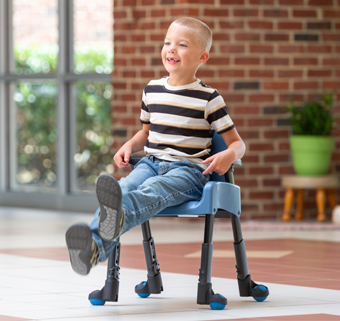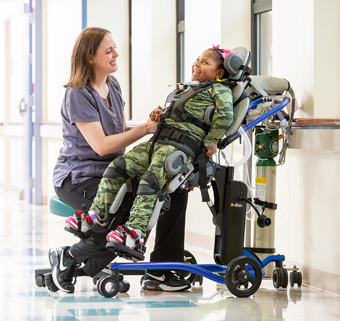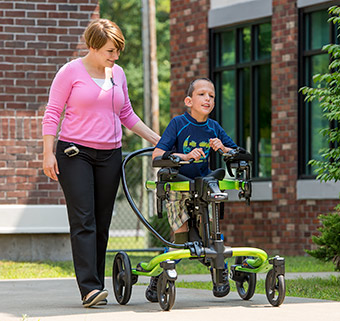Useful Tips for Writing a Letter of Educational Necessity for Adaptive Equipment
| April 2019 As a school based practitioner, I understand the challenges and frustrations of acquiring adaptive equipment for students that will help bridge the gap between their capacity and performance. The International Classification of Functioning, Disability and Health (ICF) defines capacity as the student’s abilities in a situation apart from real life, such as during an evaluation in a quiet room with no supports. Performance, on the other hand, is the interaction of the student with the environment in real-life school-routine contexts. ¹
As a school based practitioner, I understand the challenges and frustrations of acquiring adaptive equipment for students that will help bridge the gap between their capacity and performance. The International Classification of Functioning, Disability and Health (ICF) defines capacity as the student’s abilities in a situation apart from real life, such as during an evaluation in a quiet room with no supports. Performance, on the other hand, is the interaction of the student with the environment in real-life school-routine contexts. ¹
Our challenge is getting those who hold the purse strings within the school district to understand the importance of the needed equipment. Distinctly different from a Letter of Medical Necessity, which advocates on behalf of the child for funding from health insurance, this Letter of Educational Necessity is focused on the school environment. The decision-makers in administration must understand how use of the adaptive equipment will allow a student with physical disabilities to access the educational curriculum, benefit from specialized instruction, and participate in school activities.
As a therapist, I must make the argument that without the device a student will be denied a free and appropriate public education (FAPE) ² and that the student’s Individualized Education Plan (IEP) ³ will not be reasonably calculated ⁴ to meet the student’s unique needs.
Here are four tips to support your letter writing process.
1. Make the letter specific to the student’s unique needs.
Use of the student’s name and a concise description of the physical impairments and personal factors will help the reader to picture the student and will personalize the letter. (Personal factors are defined by the ICF as those factors that relate directly to this student, such as age, gender, social status, and relevant life experiences.) ¹
Make it clear to the reader that you know the specific educational setting and the student well, and fully understand his or her challenges. Inclusion of the student’s grade, placement or program type, and how the student’s disability impacts his or her ability to participate in the learning environment will enable the reader to further understand the need for adaptive equipment. Include the related service supports that the student currently receives. Be sure to use lay language!
2. Describe how the adaptive equipment will bridge the gap between capacity and performance.
Identify the requested piece of equipment and explain how it will provide the support the student needs to be an active participant in the classroom or other learning environment. Clearly describe the student’s capacity without the use of the adaptive equipment and how the student’s performance is facilitated by its use. Have concise data to support your claim and include it in the letter.
Be sure to use language that ties the use of the device to the IEP and the student’s achievement of goals and objectives. Include documented supports. Explain how the equipment allows for a reasonably calculated IEP and FAPE and that without it, the student’s FAPE may be violated.
Please note:
Remember that the administrative decision-maker will likely not be a therapist or health professional. Use terms that can be understood by an ordinary person who has never worked in healthcare or heard of the equipment; avoid abbreviations and technical jargon.
3. Illustrate with a descriptive example.
Use examples to describe the impact of the device on the student’s participation and include his or her IEP goals and objectives. All examples should be clear and specific to the student’s educational program.
To illustrate:
· The student is currently in a vocational program; explain how a mobile stander will support the student to accomplish a required work task that is an IEP goal and part of the student’s transition outcome.
· The student is working on a written classroom assignment; explain how an adaptive chair supports the trunk to allow for efficient and effective upper extremity use and completion of the writing task within the classroom timeline.
4. Explain the why!
Explain why the requested equipment matches the student’s needs and promotes participation in the learning environment. Have data that demonstrates how the equipment is necessary for the student’s academic achievement and functional performance, as documented on the IEP. Once captured on the IEP, this clarifies that the student requires the device to receive a FAPE and that the IEP is “reasonably calculated” for the student to make appropriate progress in light of his or her unique needs.
Provide a level of detail that will indicate why this particular piece of equipment with its requested accessories is superior in meeting the student’s needs as compared to other similar devices. Is it the quality of the product? The adjustability to meet the student’s unique needs? The student’s tolerance of the position? The ease of use? Its ability to support access to multiple learning environments?
Please note:
State and district guidelines often vary regarding how and where the equipment is captured within the IEP. Present levels of performance, goals and objectives, supplementary aids and services may all include documentation regarding implementation of the device and clarification of its location and manner of use. Refer to your state’s or district’s special education guidelines as a reference.
References
(1) ICF E-learning Tool Glossary Terms. (2018) Retrieved from https://www.icf-elearning.com/wp-content/uploads/articulate_uploads/ICF%20e-Learning%20Tool_2018%20-%20Storyline%20output/story_html5.html
(2) Individuals with Disabilities Education Act. (December 2015) About IDEA/IDEA Purpose. Retrieved from https://sites.ed.gov/idea/about-idea/#IDEA-Purpose
(3) Individuals with Disabilities Education Act. (December 2015) Section 1401 (26) (A) Statute/Regs Main » Statute » Subchapter I (Part A) » 1401 » 14. Individualized education program; IEP. Retrieved from https://sites.ed.gov/idea/statute-chapter-33/subchapter-I/1401/14
(4) Questions and Answers (Q&A) on U. S. Supreme Court Case Decision Endrew F. v. Douglas County School District Re-1. December 7, 2017. Retrieved from https://sites.ed.gov/idea/files/qa-endrewcase-12-07-2017.pdf and https://sites.ed.gov/idea/questions-and-answers-qa-on-u-s-supreme-court-case-decision-endrew-f-v-douglas-county-school-district-re-1/#citem_2a0b-2174




